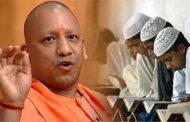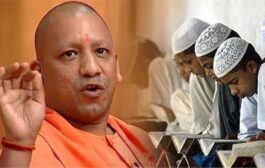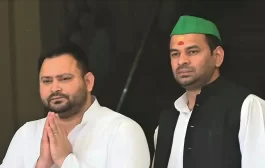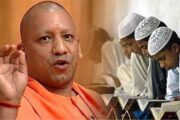Of the 14 seats in Jharkhand, five, Rajmahal, Dumka, Singhbhum, Khunti and Lohardaga, are reserved for Scheduled Tribes and Palamau is reserved for a Scheduled Caste candidate

The battle for Jharkhand began on April 29, when three constituencies went to polls in the fourth phase of the election. This election season, national issues seem to be the focus in the state which is still grappling with the BJP-led government’s attempt to amend the land rights acts and dilute the Forest Rights Acts. It is important to remember that the state has seen several protests and movements by the tribals in the last few years against those wanting to usurp their lands.
No party seems to be talking about it and hardly any party spoke about it in the 2014 election either. Maybe that is why NOTA votes seem to be higher in the ST seats than in the General seats.
Of the 14 seats in Jharkhand, five – Rajmahal, Dumka, Singbhum, Khunti and Lohardaga – are reserved for Scheduled Tribes and Palamau is reserved for a Scheduled Caste candidate.
An analysis of these six seats shows that the number of NOTA votes in these constituencies are considerably higher than in the General seats.
In 2014, 240 candidates contested elections for 14 seats in Jharkhand, of which only 31 were able to save their deposits. Of remaining 209 candidates, 128 contestants polled even less that NOTA.
Rajmahal
In Rajmahal, 12 candidates stood for the Lok Sabha Elections in 2014. It was one of the two seats which was not won by BJP in the 2014 elections. Vijay Kumar Hansdak of Jharkhand Mukti Morcha polled 3.8 lakh votes. In this constituency, 19,875 votes went to NOTA. Here seven candidates polled less than NOTA and they include candidates from AJSU Party and Bahujan Samaj Party.
This is one of the constituencies where displacement, lack of drinking water and malnutrition remain prominent issues year after year.
Dumka
This was the second seat which was not won by BJP in 2014. It was won by Shibu Soren, the chief of Jharkhand Mukti Morcha. Soren polled 3.35 lakh votes and 18,325 votes were cast in favour of NOTA. Of the 15 candidates who stood for election here, 10 got less than NOTA.
Despite being the seat of JMM chief, the constituency has seen persistent water woes, anti-displacement struggle and it was here that the infamous Kathikund firing took place. Protestors were opposing the proposed power plant by Calcutta-based and RPG Group-owned CESC Limited.
Singhbhum
This constituency polled the highest number of NOTA votes ie 27,037. This seat was won by BJP’s Laxman Giluwa and he got 3.03 lakh votes. Of the 13 candidates in fray here, eight candidates got lesser than NOTA.
This constituency has seen protests against Icha dam on the Kharkai river as the project will displace 184 villages. JMM leader Hemant Soren had led the protests demanding the scrapping of the project. This time in its manifesto, JMM has promised to review the “anti-Jharkhand” irrigation projects such as Icha Kharkai and Mandal Dam project in Palamau.
Khunti
This constituency saw 23,816 NOTA votes being polled in its favour, while the winning BJP candidate Karia Munda got 2.7 lakh votes. Of the 15 candidates here, nine polled far less than NOTA. And candidates of Babulal Marandi’s Jharkhand Vikas Morcha (Prajatantrik) and AJSU Party polled marginally above NOTA.
Besides abject poverty, this constituency being the birthplace of tribal freedom fighter Birsa Munda, has been at the forefront of the Pathalgadi movement.
Lohardaga
Here NOTA got 16,764 votes. Sudarshan Bhagat of the BJP got 2.26 lakh votes and of the 10 candidates who contested in this constituency, five got less that NOTA.
Here, some of the main issues include resistance to Bauxite mining. There were also protests against the Army’s decision to use Netarhat range in the constituency for field firing practice. In 1992, before the formation of Jharkhand, Bihar had earmarked Netarhat Hills in Gumla and Latehar for field firing practice. The tribals, fearing they might be displaced from their ancestral land had begun to protest in 1994 and eventually in 2004, the then defence minister has announced that the ministry was putting off all future artillery practices in Neterhat.
Palamau
In this constituency which borders Uttar Pradesh and Bihar, NOTA polled 18,287 votes. BJP’s Vishnu Dayal Ram got 4.76 lakh votes and of the 14 candidates in this constituency, eight candidates including that of CPI(ML) got lesser than NOTA.
This is the only Scheduled caste reserved seat in the state
Unreserved seats
In the other general seats, the share of NOTA votes was as follows: Chatra – 5791, Kodarma – 6712, Giridih – 4879, Dhanbad – 7675, Ranchi – 6900, Hazaribagh – 6827 Jamshedpur – 15629 and Godda – 12,410.
It can be seen that in the unreserved seats, Godda and Jamshedpur have a higher number of NOTA votes. That too can be attributed to the Scheduled Tribe and Schedules caste population in the region.
Jamshedpur Lok Sabha constituency comprises of six Assembly seats of which Ghatsila and Potka are reserved for Scheduled Tribes and Jugsalai is for an SC candidate. The other three have no reservation.
In Godda, there are six Assembly seats of which Deogarh has been reserved for Scheduled Caste candidates.
Several poll watchers said this trend is because hardly any political party raises their voices the marginalised tribals in Jharkhand. “Everyone is running behind development. No one wants to speak on behalf of the tribals who own the land they live on. No one wants to ensure implantation of their land rights,” said a former journalist, who did not want to be named.
“If you and I had to choose between electing an American, a German and a Japanese as Member of Parliament, we would probably opt for NOTA. In other words, we would feel that this is not a fair choice, and that the system is kind of rigged. On the other hand, not voting at all means surrendering some political power, however slim, so NOTA would seem like a better option. Perhaps some adivasis feel that way,” reasons Jean Dreze, the development economist-activist who is a Visiting Professor at the Department of Economics, Ranchi University.
source: NH







































